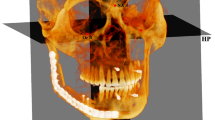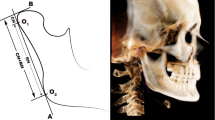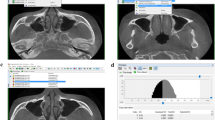Abstract
Purpose
Mandibular condyle development can be evaluated with radiographic evaluation of subchondral cortical bone. The aim of this study is to investigate mandibular condyle cortication (MCC), articular eminence cortication (AEC) and mandibular cortical index (MCI) according to age and gender on CBCT, and relationship between each other.
Methods
CBCT scans of 520 patients (312 male and 208 female, age range 7–84) were retrospectively investigated to evaluate MCC, AEC and MCI. MCC and AEC were examined in sagittal section and MCI in panoramic reformatted image. MCC and AEC were classified as Type I, Type II and Type III according to density difference between the cortical bone enclosing condyle and articular eminence. Categorical variables were tested by Chi square.
Results
When MCC, AEC and MCI were compared, a significant relationship was detected (p < 0.05). According to age, there was a significant difference between MCC, MCI and AEC types with each other (p < 0.05). No significant discrepancy was found between gender and MCC, AEC and MCI (p > 0.05).
Conclusions
This study evaluated the distribution of MCC, AEC, MCI according to age and gender and detected that these cortications were correlated. This result may be caused by anatomical proximity bone components and functional stimuli. Knowledge of these cortications can be important for accurate diagnosis of TMJ disorders and may also be helpful for prediction of osteoporotic changes.



Similar content being viewed by others
References
Ahmad M, Hollender L, Anderson Q, Kartha K, Ohrbach R, Truelove EL et al (2009) Research diagnostic criteria for temporomandibular disorders (RDC/TMD): development of image analysis criteria and examiner reliability for image analysis. Oral Surg Oral Med Oral Pathol Oral Radiol Endod 107:844–860
Alkhader M, Aldawoodyeh A, Abdo N (2018) Usefulness of measuring bone density of mandibular condyle in patients at risk of osteoporosis: A cone beam computed tomography study. Eur J Dent 12:363–368
Arnett GW, McLaughlin RP (2004) Diagnosis the case. In: Arnett GW, McLaughlin RP (eds) Facial and dental planning for orthodontists and oral surgeons, 1st edn. Mosby, California, pp 145–146
Bag AK, Gaddikeri S, Singhal A, Hardin S, Tran BD, Medina JA et al (2014) Imaging of the temporomandibular joint: an update. World J Radiol 6:567–582
Bayrak S, Halicioglu S, Kose G, Halicioglu K (2018) Evaluation of the relationship between mandibular condyle cortication and chronologic age with cone beam computed tomography. J Forensic Leg Med 55:39–44
Brooks SL, Brand JW, Gibbs SJ, Hollender L, Lurie AG, Omnell K-Å et al (1997) Imaging of the temporomandibular joint: a position paper of the American Academy of Oral and Maxillofacial Radiology. Oral Surg Oral Med Oral Pathol Oral Radiol Endod 83:609–618
Devlin H, Karayianni K, Mitsea A, Jacobs R, Lindh C, van der Stelt P et al (2007) Diagnosing osteoporosis by using dental panoramic radiographs: the OSTEODENT project. Oral Surg Oral Med Oral Pathol Oral Radiol Endod 104:821–828
Gallo LM (2005) Modeling of temporomandibular joint function using MRI and jaw-tracking technologies–mechanics. Cells Tissues Organs 180:54–68
Gupta M, Mishra P, Srivastava R, Jyoti B (2015) Cone beam computed tomography: a new vision in dentistry. Digit Med 1:7–16
Honey OB, Scarfe WC, Hilgers MJ, Klueber K, Silveira AM, Haskell BS et al (2007) Accuracy of cone-beam computed tomography imaging of the temporomandibular joint: comparisons with panoramic radiology and linear tomography. Am J Orthod Dentofacial Orthop 132:429–438
Ikeda K, Kawamura A (2009) Assessment of optimal condylar position with limited cone-beam computed tomography. Am J Orthod Dentofacial Orthop 135:495–501
Katsavrias EG (2006) Morphology of the temporomandibular joint in subjects with Class II Division 2 malocclusions. Am J Orthod Dentofacial Orthop 129:470–478
Klemetti E, Kolmakov S, Kröger H (1994) Pantomography in assessment of the osteoporosis risk group. Scand J Dent Res 102:68–72
Larheim TA (1995) Current trends in temporomandibular joint imaging. Oral Surg Oral Med Oral Pathol Oral Radiol Endod 80:555–576
Ledgerton D, Horner K, Devlin H, Worthington H (1999) Radiomorphometric indices of the mandible in a British female population. Dentomaxillofac Radiol 28:173–181
Lei J, Liu MQ, Yap AU, Fu KY (2013) Condylar subchondral formation of cortical bone in adolescents and young adults. Br J Oral Maxillofac Surg 51:63–68
Liu YY, Wang H, Yang ZY, Ba K, Li MX, Liu L (2010) The correlation between temporomandibular joint maturity and second molar root development in adolescents. Int J Stomatol 37:154–156
Morimoto Y, Konoo T, Tominaga K, Tanaka T, Yamaguchi K, Fukuda J et al (2007) Relationship between cortical bone formation on mandibular condyles and alternation of the magnetic resonance signals characteristic of growth. Am J Orthod Dentofacial Orthop 131:473–480
Renders GAP, Mulder L, van Ruijven LJ, van Eijden TMGJ (2007) Porosity of human mandibular condylar bone. J Anat 210:239–248
Renders GAP, Mulder L, van Ruijven LJ, van Eijden TMGJ (2006) Degree and distribution of mineralization in the human mandibular condyle. Calcif Tissue Int 79:190–196
Rozylo-Kalinowska I, Orhan K (2019) Imaging of the Temporomandibular Joint. In: Rozylo-Kalinowska I, Orhan K (eds) Cone beam computed tomography (CBCT) in TMJ imaging, 1st edn. Springer Nature, Switzerland, pp 125–131
Sano T, Westesson PL, Larheim TA, Takagi R (2000) The association of temporomandibular joint pain with abnormal bone marrow in the mandibular condyle. J Oral Maxillofac Surg 58:254–257
Secgin CK, Gulsahi A, Yavuz Y, Kamburoglu K (2019) Comparison of mandibular index values determined from standard panoramic versus cone beam computed tomography reconstructed images. Oral Surg Oral Med Oral Pathol Oral Radiol 127:257–264
Uysal S, Çağırankaya BL, Hatipoğlu MG (2007) Do gender and torus mandibularis affect mandibular cortical index? A cross-sectional study. Head Face Med 3:37
van Eijden TMGJ, van der Helm PN, van Ruijven LJ, Mulder L (2006) Structural and mechanical properties of mandibular condylar bone. J Dent Res 85:33–37
White SC, Pharoah MJ (2014) Oral radiology: principles and interpretation. In: White SC, Pharoah MJ (eds) Cone beam computed tomograph: anatomy, 7th edn. Mosby, St. Louis, pp 214–228
White SC, Taguchi A, Kao D, Wu S, Yoon D, Suei Y et al (2005) Clinical and panoramic predictors of femur bone mineral density. Osteoporos Int 16:339–346
Yalcin ED, Avcu N, Uysal S, Arslan U (2019) Evaluation of radiomorphometric indices and bone findings on panoramic images in patients with scleroderma. Oral Surg Oral Med Oral Pathol Oral Radiol 127:23–30
Zain-Alabdeen EH, Alsadhan RI (2012) A comparative study of accuracy of detection of surface osseous changes in the temporomandibular joint using multidetector CT and cone beam CT. Dentomaxillofac Radiol 41:185–191
Funding
No funding resource is associated with this study.
Author information
Authors and Affiliations
Corresponding author
Ethics declarations
Conflict of interest
The authors declare that they have no conflict of interest.
Informed consent
Formal consent is not required.
Ethical approval
This retrospective study was approved by the Ethical Committee of Gaziantep University (Decision No: 2019/29) and conducted in the Dentomaxillofacial Radiology Department of Gaziantep University, Faculty of Dentistry.
Additional information
Publisher's Note
Springer Nature remains neutral with regard to jurisdictional claims in published maps and institutional affiliations.
Rights and permissions
About this article
Cite this article
Yalcin, E.D., Bozan, C. Relationship between mandibular condyle and articular eminence cortication with mandibular cortical index on cone-beam CT. Surg Radiol Anat 42, 515–522 (2020). https://doi.org/10.1007/s00276-019-02385-7
Received:
Accepted:
Published:
Issue Date:
DOI: https://doi.org/10.1007/s00276-019-02385-7




